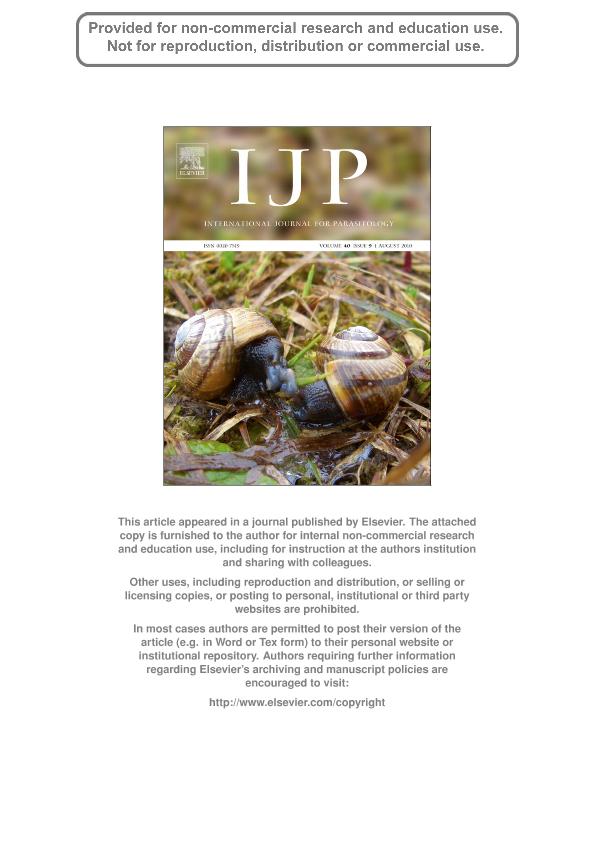Mostrar el registro sencillo del ítem
dc.contributor.author
Westergaard, Gaston G.
dc.contributor.author
Bercovich, Natalia

dc.contributor.author
Reinert, Marina Daniela

dc.contributor.author
Vazquez, Martin Pablo

dc.date.available
2019-07-15T20:40:28Z
dc.date.issued
2010-08
dc.identifier.citation
Westergaard, Gaston G.; Bercovich, Natalia; Reinert, Marina Daniela; Vazquez, Martin Pablo; Analysis of a nuclear localization signal in the p14 splicing factor in Trypanosoma cruzi; Elsevier; International Journal for Parasitology; 40; 9; 8-2010; 1029-1035
dc.identifier.issn
0020-7519
dc.identifier.uri
http://hdl.handle.net/11336/79585
dc.description.abstract
There are only a few reported nuclear localization signals (NLS) in trypanosomes despite intensive research on nuclear metabolic processes such as mRNA processing and transcription during the recent past. Moreover, there are only two reports for a monopartite (La protein) and bipartite (H2B histone, ESAG8) NLS in Trypanosoma brucei. We decided to investigate a NLS in Trypanosoma cruzi by selecting p14, a small RNA recognition motif (RRM) containing protein involved in the splicing process in the nucleus. Its small size (117 amino acids), and an optimized streamlined workflow for analysis in T. cruzi, allowed us to define a region of basic amino acids (RRKRRR) located at the C-terminus that is necessary for nuclear localization. However, the NLS for p14 appeared to be more complex since the signature RRKRRR alone is necessary but not sufficient to direct heterologous proteins, such as GFP, to the nucleus. Since p14 interacts strongly with splicing factor SF3b155, a much larger protein, we designed a p14 variant unable to interact with it. The results allowed us to discard the notion that p14 is entering the nucleus, or is retained within, as the sole consequence of being part of a larger complex. Extensive mapping showed that all of the information for nuclear import resides within the small p14 protein in a bipartite NLS composed of the signature RRKRRR and a region of the RRM domain. Thus, NLS definition in T. cruzi is more complex than previously described.
dc.format
application/pdf
dc.language.iso
eng
dc.publisher
Elsevier

dc.rights
info:eu-repo/semantics/openAccess
dc.rights.uri
https://creativecommons.org/licenses/by-nc-sa/2.5/ar/
dc.subject
Gateway Vector
dc.subject
Nls
dc.subject
P14
dc.subject
Ptrex
dc.subject
Splicing Factor
dc.subject
Trypanosoma
dc.subject.classification
Bioquímica y Biología Molecular

dc.subject.classification
Ciencias Biológicas

dc.subject.classification
CIENCIAS NATURALES Y EXACTAS

dc.title
Analysis of a nuclear localization signal in the p14 splicing factor in Trypanosoma cruzi
dc.type
info:eu-repo/semantics/article
dc.type
info:ar-repo/semantics/artículo
dc.type
info:eu-repo/semantics/publishedVersion
dc.date.updated
2019-07-10T19:05:29Z
dc.journal.volume
40
dc.journal.number
9
dc.journal.pagination
1029-1035
dc.journal.pais
Países Bajos

dc.journal.ciudad
Amsterdam
dc.description.fil
Fil: Westergaard, Gaston G.. Universidad de Buenos Aires. Facultad de Ciencias Exactas y Naturales. Departamento de Fisiología, Biología Molecular y Celular; Argentina
dc.description.fil
Fil: Bercovich, Natalia. Consejo Nacional de Investigaciones Científicas y Técnicas. Instituto de Investigaciones en Ingeniería Genética y Biología Molecular "Dr. Héctor N. Torres"; Argentina. Max Planck for developmental Biology; Alemania
dc.description.fil
Fil: Reinert, Marina Daniela. Consejo Nacional de Investigaciones Científicas y Técnicas; Argentina. Universidad de Buenos Aires. Facultad de Ciencias Exactas y Naturales. Departamento de Fisiología, Biología Molecular y Celular; Argentina
dc.description.fil
Fil: Vazquez, Martin Pablo. Consejo Nacional de Investigaciones Científicas y Técnicas. Instituto de Investigaciones en Ingeniería Genética y Biología Molecular "Dr. Héctor N. Torres"; Argentina. Universidad de Buenos Aires. Facultad de Ciencias Exactas y Naturales. Departamento de Fisiología, Biología Molecular y Celular; Argentina
dc.journal.title
International Journal for Parasitology

dc.relation.alternativeid
info:eu-repo/semantics/altIdentifier/url/http://www.sciencedirect.com/science/article/pii/S002075191000069X
dc.relation.alternativeid
info:eu-repo/semantics/altIdentifier/doi/https://doi.org/10.1016/j.ijpara.2010.02.011
Archivos asociados
